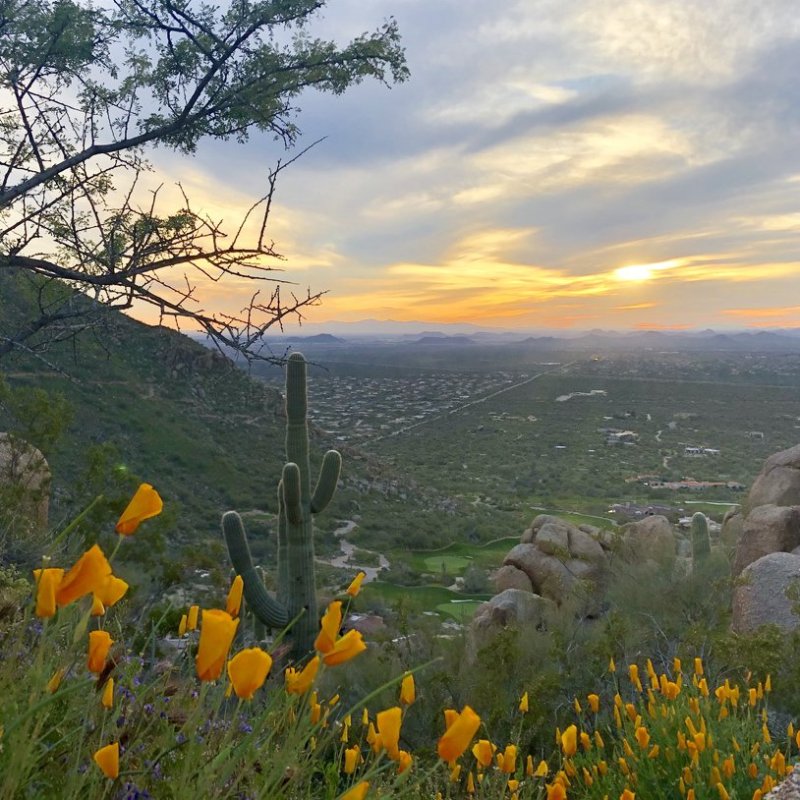
With its quirky little desert towns, endless open roads, and booming cities, Arizona is tailor made for road trips.
Videos by TravelAwaits
Although the routes are virtually limitless, one of the best and most well traveled road trips is the trek from the state’s major population center of Phoenix to the world-renowned beauty of Sedona.
Depending on the season, the 120-mile trip is likely to yield classic Southwestern views such as towering saguaro cacti, wildflowers in a rainbow of colors, and mining and ranching historical sites — not to mention the stunning red rocks of Sedona.
While the trip could be done in a quick 2-hour drive up Interstate 17 and Highway 179, the more interesting option includes a detour through the lovely Verde Valley, along with stops at a national monument, two state parks, and an environmental enclave.

Phoenix
As the fifth-largest city in the United States, Phoenix has a multitude of attractions, neighborhoods, and resorts from which to choose. If your trip to Arizona is focused on a road trip to Sedona, I suggest staying in Scottsdale, located in the northeastern section of Phoenix’s sprawling Valley of the Sun metro area.
There, you’ll find a year-round array of memorable Arizona activities — everything from cheering on your favorite Major League Baseball team at a spring training game (typically from mid-February through late March) and taking in a gorgeous desert sunset at the Pinnacle Peak Park to dining canalside at the upscale Scottsdale Waterfront and relaxing in a lazy river at the luxurious Westin Kierland Resort & Spa.
Other not-to-be-missed attractions include Phoenix’s host of unique restaurants and bars as well as its spectacular desert hiking. Plan to stay for three or four days, and you will have time to take in the magnificent Desert Botanical Garden, Frank Lloyd Wright’s winter home at Taliesin West, and the Native American treasures at the Heard Museum.
From Scottsdale, it’s easy to get to Interstate 17 to begin your journey north.

Black Canyon City
Less than an hour north of Phoenix is the Old West outpost of Black Canyon City, where travelers have been stopping at the Rock Springs Cafe for sustenance for more than a century. It’s a great spot for Arizona breakfast favorites such as biscuits and gravy and breakfast burritos. The cafe is also famous for its pies, so you might want to stock up on a signature cherry crumb or apple bourbon.
The nearby Black Canyon Trail is also worth checking out for its giant saguaro cacti and plentiful wildflowers in the spring. The trail runs north-south for 80 miles, but you can sample a few miles of it by stopping at the Black Canyon City Trailhead, where a short walk will get you into a forest of saguaros. The trail is rated as intermediate and is recommended only from November through April. Plan to spend about 2 hours on an out-and-back trek.

Agua Fria National Monument
Another stellar fall, winter, and spring hiking opportunity is available just a half hour north of Black Canyon City at the Agua Fria National Monument. The massive 71,000-acre national monument encompasses two mesas and the canyon of the Agua Fria River. The Badger Springs Trail features a shady walk down a trickling wash to the larger flow of the Agua Fria River.
Along the way, keep an eye out for prehistoric petroglyphs (rock art carvings), wildflowers, and a variety of desert wildlife. The interstate’s Badger Springs exit takes you to a dirt road, where a short drive will get you to the trailhead. The hike to the river is less than a mile and is rated as easy; 2 or 3 hours will allow for a refreshing dip in the river and a picnic lunch. Note that river flows tend to fluctuate with the seasons.

Arcosanti
Billed as “the most unique architecture and ecology experiment in Arizona,” the experimental community of Arcosanti lies just over an hour north of Phoenix near the small town of Cordes Lakes.
Created by architect Paolo Soleri in 1970, Arcosanti is an urban laboratory that offers walk-through demonstrations and tours that focus on efficient alternatives to urban sprawl. Arcosanti also offers a cafe and a molten bronze bell-casting business. The website suggests scheduling a tour. An hour or two should give you a taste of the community.

Camp Verde
For a glimpse of life as a frontier soldier, consider stopping at the Fort Verde State Historic Park in the nearby town of Camp Verde. The fort was the base for General George Crook’s U.S. Army scouts and soldiers in the 1870s and 1880s and has been well preserved over the decades.
Camp Verde also provides access to the Verde River, a true oasis in the desert. Canoeing, kayaking, fishing, and picnicking are all popular activities at the town’s White Bridge Picnic Site.
Or, if you’re in the mood for a lively casino setting, Camp Verde is home to Cliff Castle Casino, a gaming, dining, recreation, and lodging enterprise of the Yavapai-Apache Nation. The casino, located just off the interstate, offers a number of dining options, including a buffet, restaurant, cafe, and marketplace for snacks and grab-and-go items.
Expect to spend a half day or so exploring Camp Verde.

Cottonwood
Rather than continuing north on Interstate 17 from Camp Verde, head northwest on Highway 260 to the midsize town of Cottonwood. At less than a half hour from Sedona, Cottonwood is a convenient and less-expensive option for accommodations.
It also boasts a fun atmosphere all its own. For the liveliest scene, make your way to historic Old Town Cottonwood, where a row of charming vintage buildings house a surprisingly robust choice of eateries, wine-tasting options, and hotels. For an indoor-outdoor dining venue, I recommend Pizzeria Bocce, where you can choose to sit around a patio firepit in the cool-weather months or in a hip dining room in the heat of summer.
Just up the street, the Tavern Hotel offers boutique lodging choices in a renovated 1920s-era building that once served as a grocery store. Or if you’re longing for a leafy-green camping experience, Dead Horse Ranch State Park is hard to beat, with its giant cottonwood trees and pretty fishing lagoons. An overnight stay in Cottonwood would allow you to take in the main attractions.

Clarkdale
Mining, railroad, and Native American histories converge in Clarkdale, a small town 4 miles northwest of Cottonwood. Many of the town’s brick and stucco houses date to the mining days of the early-to-mid-1900s, when Clarkdale was a “company town” of the United Verde Copper Company.
For a splendid view of one of the railroads that served the mines, hop aboard the Verde Canyon Railroad, which was built in 1911 and was brought back to life in 1990 to carry sightseers along the river-carved canyon.
Overlooking it all is the Tuzigoot National Monument, an ancient pueblo that sits high atop a hill above the Verde River. The pueblo, built by the Sinagua people centuries ago, was excavated and preserved in the 1930s. If you plan to take the 3.5-hour train ride, expect to spend 5 or 6 hours in Clarkdale.

Jerome
You shouldn’t visit the Verde Valley without taking the 10-minute, steep, and twisting drive up to Jerome. This popular mining town, known through the years as the “Wickedest City in the West,” was a ghost town, an artist colony, and finally, a tourist destination.
Perhaps the best pastime in Jerome is to walk its steep streets and take in the ruins. Jerome is also a wonderful place for a lunch break, and virtually every visitor ends up at some point at The Haunted Hamburger, a cool ghost-themed eatery perched on the edge of the mountain. Other prominent attractions include the Jerome Historical Society Mine Museum, the Gold King Mine, the Asylum Restaurant, and the Connor Hotel Bar. You can expect to spend 3 to 4 hours dining and exploring.

Sedona
From the Verde Valley, Sedona is a 20-mile drive northeast on Highway 89A. Visitors could easily spend weeks hiking Sedona’s stellar trails and driving the scenic byways, but if you have just a day or two, I recommend starting out by spending 2 or 3 hours on one of the iconic hikes, such as the easy West Fork Trail or the moderate Devil’s Bridge Trail.
From there, head to Uptown Sedona, where you can choose from a huge assortment of eateries such as 89Agave and the Open Range Grill & Tavern. If souvenir shopping is on your agenda, Uptown is the place for it, and there are numerous spots where you can find crystals, Southwestern art, and jewelry.
A drive north through Oak Creek Canyon should also be on your list of must-dos. Plan to spend several hours, allowing for possible traffic jams and sightseeing stops at Slide Rock State Park or Indian Gardens Cafe & Market.
Among Sedona’s other prominent attractions are Bell Rock in the Village of Oak Creek, the Tlaquepaque Arts & Shopping Village, and Red Rock State Park. For something more offbeat, consider taking a Sedona Jeep tour or finding the energy at Sedona’s famous vortexes.
Accommodations in Sedona range from small and tranquil to deluxe and full service. For a bed and breakfast experience, consider A Sunset Chateau, and for a splurge, check out the luxurious Enchantment Resort. Plan for two to three days in Sedona in order to explore and relax.
What To Know Before You Go
Sedona’s stunning beauty makes it a bucket-list-worthy destination, and millions flock there each year. That means that the small town of just over 10,000 is often thronged with visitors. The town’s tourism department recommends winter, with its mild temperatures, as the best season to visit.
If you do visit during the busier seasons, try to time your road trip so that you are not heading north on Interstate 17 on Friday or Saturday or heading south on Sunday. Those are the times when all of Phoenix seems to be traveling to or from the high country of Northern Arizona at the same time. Especially on long holiday weekends, the interstate can become clogged with stop-and-go traffic for miles.
